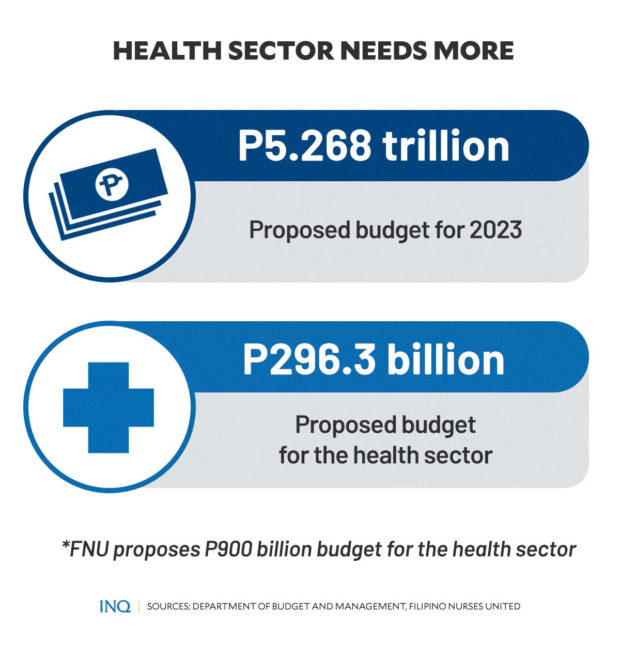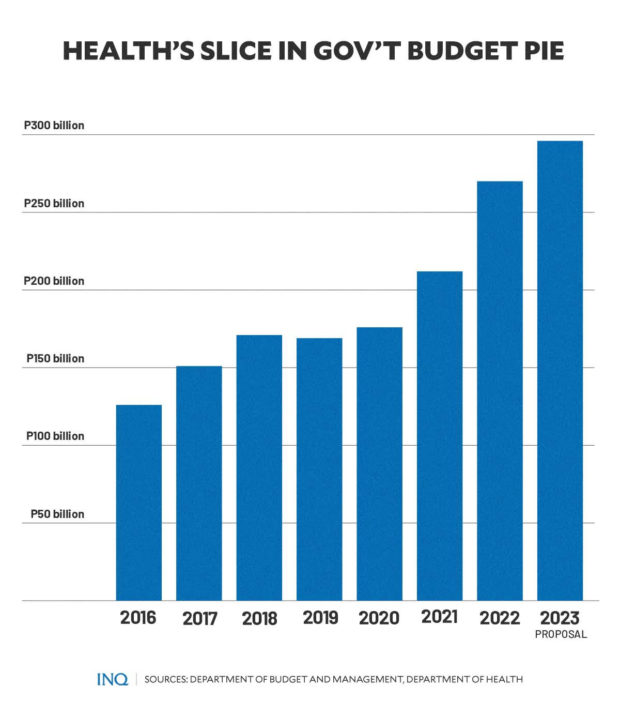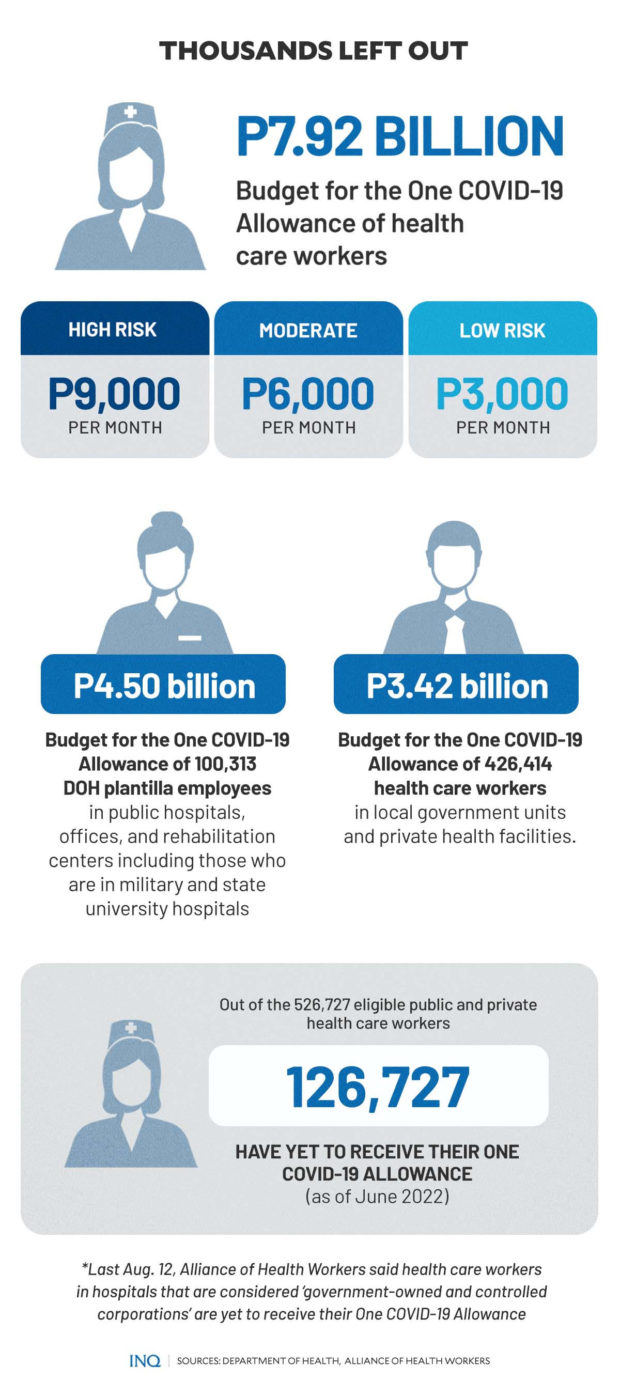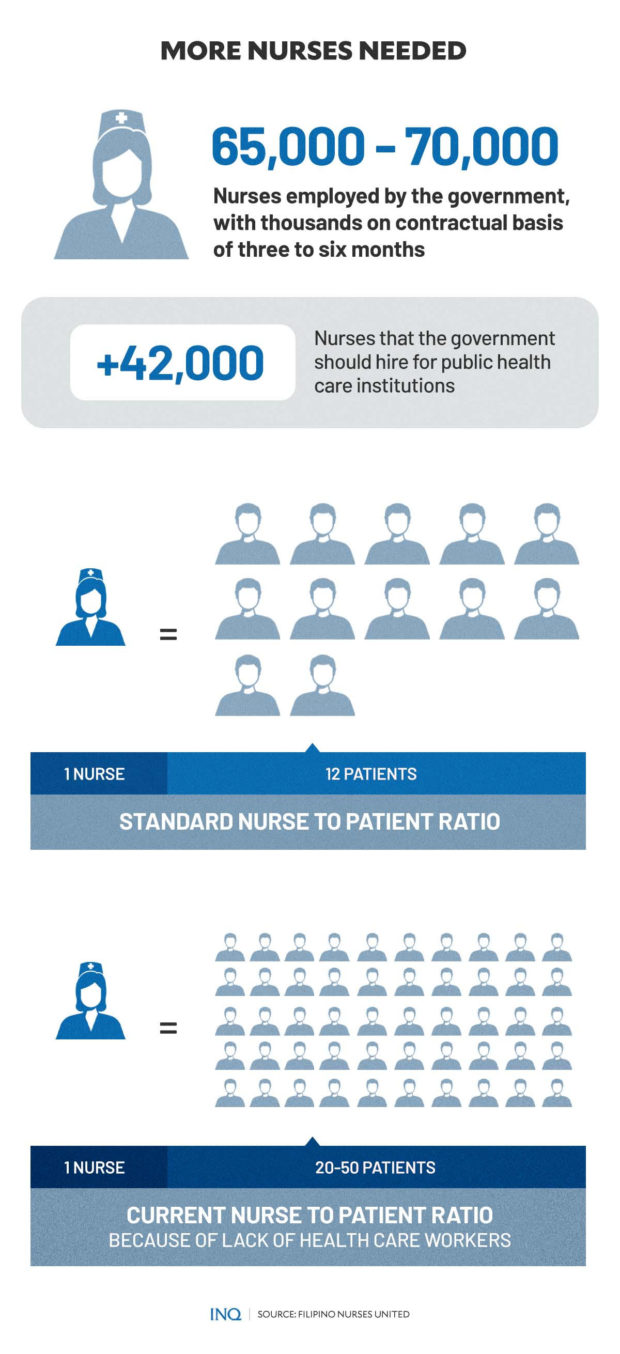P296.3-B health budget for 2023: Higher but still ‘not enough’
MANILA, Philippines—The proposed P296.3 billion budget for the health sector next year seemed enormous, but given the problems confronting the country’s health care system, the group Filipino Nurses United (FNU) said it was not enough.
It was last Monday (Aug. 22) when the Department of Budget and Management (DBM) submitted to Congress the proposed P5.268 trillion national budget for 2023, and part of it is the P296.3 billion that the health sector is expected to receive.
The proposal, which is 4.9 percent higher than this year’s allotted, has allocated most of the proposed P5.268 trillion for education (P852.8 billion), infrastructure (P718.4 billion), health (P296.3 billion), agriculture (184.1 billion), and social protection (P197 billion).
It was stressed by the DBM that the P296.3 billion proposed budget for the health sector is 10.4 percent higher than this year’s to strengthen the health care system, especially with the still existing threats of infectious diseases.
Budget Secretary Amenah Pangandaman said P29 billion has been allocated for the procurement of medicines and vaccines, while P19 billion has been earmarked for the salary and benefits of health care workers.
Article continues after this advertisementLikewise, the Health Facilities Enhancement Program, which will fund the procurement of new medical equipment as well as the construction and rehabilitation of government’s health care facilities.
Article continues after this advertisementBut FNU said the P296.3 billion proposed budget for the health sector is not enough to address the health crisis, including the lack of health care workers in government hospitals.
It said the administration of President Ferdinand Marcos Jr. should prioritize people’s health and the wellbeing of health care workers by increasing the national health budget to P900 billion or 10 percent of gross domestic product.
Heath workers’ benefits
Considering that the Department of Health (DOH) has been “falling short” of providing COVID-19 benefits, such as the One COVID-19 Allowance (OCA), and the need to increase the salary of nurses, the FNU said it was bothered by the allocation.
Last Feb. 17, the DBM released P7.92 billion to the DOH for the OCA of 526,727 eligible public and private health care workers who are identified to be at high risk (P9,000); medium risk (P6,000), and low risk (P3,000).
RELATED STORY: ‘Suicide mission’: Cutting short isolation of health workers with COVID
The OCA shall be given in full provided that the health professional physically reports to work for at least 96 hours every month. Otherwise it shall be prorated, the DOH said.
Out of the P7.92 billion, P4.50 billion is for OCA of 100,313 DOH plantilla employees in public hospitals, offices, and rehabilitation centers including those who are in military and state university hospitals.
The remaining, P3.42 billion, is for OCA of 426,414 health care workers in local government units and private health facilities. But last June, the DOH said 126,727 health care workers have not yet received their OCA.
Health Undersecretary Leopoldo Vega had told radio station dzBB that the DOH was already coordinating, especially with the Private Hospitals Association of the Philippines, about the list of hospitals with health care workers who have not yet received their OCA.
Vega stressed that health care workers who have not yet received their OCA will do so under the Marcos administration, but last Aug. 12, the Alliance of Health Workers (AHW) said some health care workers have yet to receive that allowance.
This, as health care workers in hospitals that are classified as “government-owned and controlled corporations” staged protests to call on the DOH to immediately distribute their OCA.
READ: Health workers from GOCC-hospitals complain about delayed COVID-19 allowance
They said health care workers at the Philippine Heart Center (PHC) have so far only received their OCA in January 2022, while those from the National Kidney and Transplant Institute (NKTI) have so far just received their OCA for January to March.
“It is so discouraging and exasperating that when it comes to our much deserved COVID-19 benefits, the DOH and this government always [have] no budget to allocate,” said Salome Ejes, acting president of AHW-PHC.
Preventing nurses’ exodus
FNU stressed that increasing the salary of nurses is seen as an “immediate and effective remedy” to prevent them from leaving the Philippines because of low pay and lack of improvement in working conditions.
Citing data from the DOH, it said out of 915,219 registered nurses in the Philippines, 316,415, or one-third, had already migrated, while 124,999 nurses are without any specified field of practice.
RELATED STORY: Nurses’ exodus: Hailed as heroes, treated like peons
This, as the average entry level pay of nurses in the Philippines is only P8,000 to P13,500 every month, too small compared to the entry level pay in the United States ($3,800), United Kingdom (£1,662) and Canada ($4,097).
Last June, Marie Umalla, 24, who left for the United Arab Emirates, had told INQUIRER.net that “with how my work was being compensated, I won’t be able to provide for the needs of my family. This was the reason that I decided to leave.”
READ: Nurses’ exodus: Choice obvious between better future abroad, shabby treatment at home
The DOH had asked the government to implement measures to stop the migration of health care workers, especially nurses, saying that “this should be a whole-of-government approach”.
READ: DOH urges gov’t to stop exodus of PH health workers
“The so-called brain drain in the country needs to be addressed by the government, because we need our health care workers to stay here in the country to help our health care system.”
It said it is working to resolve the problems being confronted by nurses: “We are incentivizing our nurses. We’re giving them health care benefits and allowances, so they’ll be more interested in working in our country.”
But FNU stressed that a higher and adequate national health budget will ”very well” respond to a proposal to increase the entry-level pay of nurses in public and private hospitals, with subsidies to private health care clinics.
Likewise, it said the government should hire 42,000 more nurses to address the lack of health care workers, noting that only 65,000 to 70,000 were employed by the government, with thousands on contractual basis for three to six months.
READ: Hospitals: Where have all the nurses gone?
This, as nurses have been “burdened” with 20 to 50 patients every shift when the ideal nurse-to-patient ratio is 1:12.
FNU stressed that in government hospitals, though nurses have relatively higher pay, they suffer from work and patient overload in the same way as those in private hospitals do.
Strengthen public health system
The Universal Health Care Act was signed by then President Rodrigo Duterte in 2019, but access to quality and inexpensive health care, and even the lack of nurses, are still confronting millions of Filipinos.
The University of the Philippines had said that “six out of 10 Filipinos die without even seeing a doctor” and that “the high cost of health care in the country prevents people from accessing life-saving services, and drowns families further into poverty.”
RELATED STORY: Health group to gov’t: Ensure planned specialty hospitals provide quality care
Based on data from the Philippine Statistics Authority (PSA), six out of 10 deaths in 2016 were not medically attended, indicating that out of the 582,183 registered deaths that year, 342,705 were not attended by a health professional.
The PSA said only Metro Manila had a greater number of medically attended deaths (42,045) than those that were not attended (34,669). This meant that Metro Manila “has better access to health facilities”.
The top three regions which had the most deaths that were not attended by a health professional were Calabarzon (48,507), Central Luzon (42,832) and even Metro Manila (34,669).
FNU said many Filipinos get sick and die of poverty and preventable diseases. Ronnie Baticulon said in a CNN Philippines column that every year, one million patients are driven to poverty because of catastrophic health expenses.
“Public health care should be strengthened by providing an adequate budget for essential, life-saving medicines, vaccines, modern equipment and ensuring adequate nurses and other health care workers,” FNU said.
This, as it stressed that the government should not fall short in responding to the continuing COVID-19 crisis, the increase of infectious diseases such as dengue and the threat of emerging diseases, like monkeypox.
When Marcos delivered his first State of the Nation Address last month, he said he would want to add more specialized hospitals, like the PHC and NKTI, in the regions to extend medical assistance to Filipinos.
“It’s clear to us that we need these types of hospitals outside the National Capital Region,” he said.
RELATED STORY: DOH to build 7 specialty facilities outside Metro Manila
But the proposed 2023 budget for the University of the Philippines system, which includes the Philippine General Hospital (PGH), has decreased by almost P2.5 billion, indicating that the proposed budget for the PGH went down by P893 million.
READ: UP system faces P2.5-B cut in proposed 2023 budget; P893-M slashed from PGH
Neglect from the past
The PWC had said that the problem of inequality still exists as health care remains out of reach for many people: “The absence of an integrated health network has had a negative impact on economic and geographic access, as well as on quality and efficiency of health services.”
The think tank Ibon Foundation said the Duterte administration, which preceded Marcos’, “severely neglected the public health system of the country.”
“In the past six years, the government has not taken significant measures that will strengthen the public health system and make health services accessible and equitable to the Filipino people.”
It said Duterte’s budget for the health sector then was “low and misallocated”.
Based on data from the DOH, the allocation for the health sector, which includes the department and the Philippine Insurance Health Corporation (PhilHealth), was only P270 billion in 2022, P212 billion in 2021, P176 billion in 2020, P169 billion in 2019, P171 billion in 2018, P151 billion in 2017, and P126 billion in 2016.
“First, Duterte’s health sector budget remains low and misallocated. Every year, the budget share of the health sector is much lower compared to the country’s military and infrastructure budget. For 2022, the Department of Public Works and Highways got 15.7 percent or P786.6 billion while the Department of National Defense got 4.4 percent or P220.9 billion,” Ibon Foundation said.
It explained that a large slice of the small budget for the health sector in 2022 went to social health insurance and not to direct health services such as the operational budget of several government hospitals and laboratories.
For 2022, 30 percent went to PhilHealth, while the remaining 70 percent went to the DOH: “Out of the total DOH budget, only P55 billion is allocated for the operation of DOH hospitals and other regional health facilities, national laboratories, and blood centers.”
The think tank likewise said that despite the Duterte administration’s focus on infrastructure projects, there is a glaring lack of health infrastructure built.
“Only four out of 112 of the administration’s Infrastructure Flagship Projects are dedicated to the health sector, compared to 76 projects dedicated to transport and mobility.”




